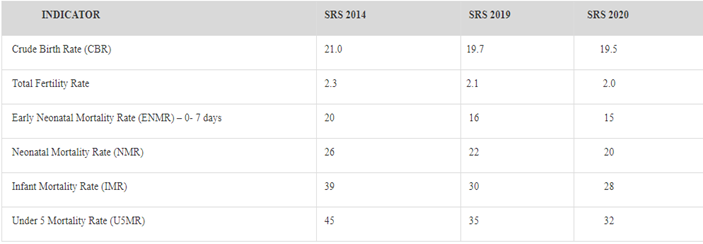In News:
- According to the Registrar General of India's (RGI) Sample Registration System Statistical Report 2020, Uttarakhand has the worst (844) sex ratio (number of females per 1,000 males) at birth in the country and Kerala has the best (974).
- According to the recently released report, India has achieved a significant milestone in further lowering child mortality rates.
What’s in today’s article:
- About the Sample Registration System (SRS)
- About the Sample Registration System Statistical Report 2020
About the Sample Registration System (SRS):
- SRS in India is one of the largest demographic surveys in the world covering about 8.2 million sample population.
- It is carried out by the Office of Registrar General & Census Commissioner of India.
- Registrar General and Census Commissioner of India is a permanent department under the Ministry of Home Affairs, Government of India.
- The office was founded in 1961 for arranging, conducting and analysing the results of the demographic surveys of India including Census of India and Linguistic Survey of India.
- The position of Registrar is usually held by a civil servant holding the rank of Joint Secretary.
- It is conducted with an objective of providing reliable annual estimates of birth rate, death rate, infant mortality rate and various other fertility and mortality indicators through an SRS Statistical Report.
- SRS (a joint effort of the Central and State Governments) has been serving as the main source of information on fertility and mortality both at the State and National levels, from 1971 onwards.
- The SRS Statistical Report includes data on population composition by broad age groups, sex and marital status.
- The indicators in this report are brought out for India and bigger States or UTs (with population 10 million and above) separately for rural and urban areas.
The Sample Registration System Statistical Report 2020:
- About:
- The present Report contains data on fertility and mortality indicators for the year 2020 for India and bigger States or UTs.
- The estimates are segregated by residence and also by gender, wherever required.
- Key highlights of the report:
- Sex ratio at birth:
- The overall sex ratio at birth in the country increased to 907 in 2018-20 (907 in the rural and 910 in the urban areas) from 904 in 2017-19.
- The ratio may reflect the number of pre-natal sex determinations and female foeticide cases.
- Meanwhile, Uttarakhand's sex ratio fell four as it had stood at 848 in the last RGI report for the 2017-2019 period.
- Kerala (973) and Uttarakhand (853), respectively, had the highest and lowest sex ratios at birth in rural areas.
- In urban areas, the sex ratio at birth ranged from 975 in Kerala to 821 in Uttarakhand.
- Five generations have passed since the skewed sex ratio at birth in Uttarakhand, but 70% of women still lack access to family wealth, higher education and health resources.
- Within their own families, women are still passively conditioned to accept themselves as "second-class citizens."
- The ability to make decisions, speak out without fear and develop as a responsible, productive global citizen has waned.
- Child mortality rates:

- In a significant milestone, India has achieved landmark achievement in further reduction of child mortality rates.
- As per the report, the country has been witnessing a progressive reduction in IMR, U5MR and NMR since 2014 towards achieving the Sustainable Development Goals (SDG) targets by 2030.
- Six States/UT have already attained SDG target of NMR (<=12 by 2030): Kerala (4), Delhi (9), Tamil Nadu (9), Maharashtra (11), Jammu & Kashmir (12) and Punjab (12).
- Eleven States/UT have already attained SDGs target of U5MR (<=25 by 2030): Kerala (8), Tamil Nadu (13), Delhi (14), Maharashtra (18), J&K (17), Karnataka (21), Punjab (22), West Bengal (22), Telangana (23), Gujarat (24), and Himachal Pradesh (24).










